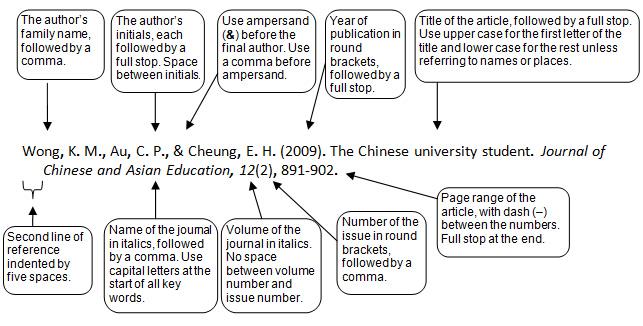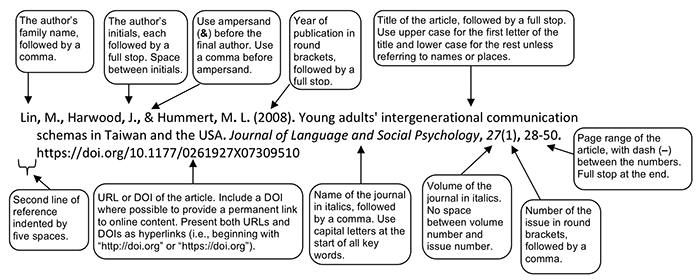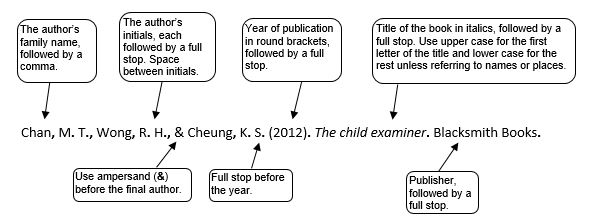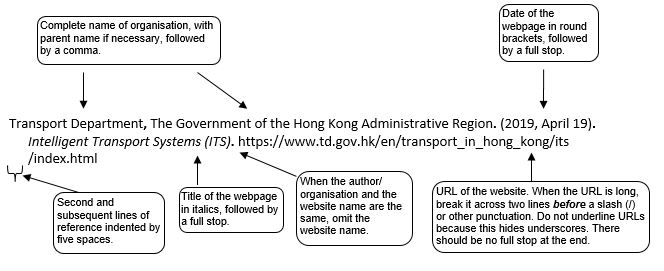APA Referencing Guide
The APA 7th edition referencing system 
The page was last updated on 13 June 2023.
Referencing is a standard practice for acknowledging information sources in academic writing at university. Whenever you write an assignment that requires you to find and use information, you are expected to reference all the sources of information and ideas included in your writing.
This webpage provides guidelines for using the APA 7th edition referencing system. There are two components to an APA reference:
- an in-text reference in the body of your assignment:
Bland and Osterwalder (2019) explore a range of themes and ideas ... - full reference details in your reference list:
Bland, D. J., & Osterwalder, A. (2019). Testing business ideas: A field guide for rapid experimentation. John Wiley & Sons.
Part 1 Basic rules
Why do we reference?
Most academic assignments require wide reading so that previous and current thinking about a particular topic can be identified. It is important to show your reader that you have sought out expert, reliable sources to help support and develop your thinking on your topic. The referencing in your assignment should:
- demonstrate good research practice
- show the range of ideas and approaches you have found and thought about
- acknowledge where those ideas came from
- tell your reader where they can locate the sources you have used
Referencing also helps you to avoid plagiarism. If you present someone else's ideas, and/or the way they express their ideas, as if they are your own work, you are committing plagiarism. Plagiarism can be unintentional due to poor referencing, but the consequences are always serious. Accurate referencing helps you to avoid this.
- paraphrase someone else's ideas in your own words
- summarise someone else's ideas in your own words
- quote someone else's ideas in their exact words
- copy or adapt a diagram, table or any other visual material
- use a direct quote from a particular source
- copy tables or figures, or present specific information like data/statistics
- According to Palladino and Wade (2010), "a flexible mind is a healthy mind" (p. 147).
- In 2010, Palladino and Wade noted that "a flexible mind is a healthy mind" (p. 147).
- In fact, "a flexible mind is a healthy mind" (Palladino & Wade, 2010, p. 147).
- "A flexible mind is a healthy mind," according to Palladino and Wade’s (2010, p. 147) longitudinal study.
- Palladino and Wade’s (2010) results indicate that "a flexible mind is a healthy mind" (p. 147).
1. When to reference
Every time you include someone else's words, ideas or information in your assignment, an in-text reference must be provided. Insert an in-text reference whenever you:
2. How to reference
An in-text reference is provided each time you refer to ideas or information from another source, and includes the following details:
the author's family name (do not include given names) + the year of publication + page numbers when needed.There are two main ways to present an in-text reference:
a) Integral referencing
The reference is in the body of your sentence, with the author's family name integrated into the sentence structure and the date given in brackets. This type of reference is often used when you want to give prominence to the author.
b) Non-integral referencing
The reference is enclosed in the sentence in brackets. This type of reference is often used when you want to give prominence to the information.
The Hong Kong economy expanded by 2.3% in the third quarter of 2011 (Census and Statistics Department, 2012).
3. Including page numbers
Page numbers should be included when you:
There are many ways to cite a direct quotation. It is recommended that the page number should be placed after the quotation. See below for examples:
You can also include a page number when you take an idea from a particular page. However, it would not be appropriate academic style to include a page number in all or most of your in-text citations if you are only taking ideas from a source.
4. Use of "et al."
Where there are three or more authors, only the first author should be used followed by "et al." (which is Latin for et alia) meaning 'and others':
Wong et al. (2005) found that the majority ...or as a non-integral reference:
Recent research (Wong et al., 2005) has found that the majority of ...The following chart shows how to format in-text citations for APA 7th edition referencing style:
| Number of authors | Integral citation | Non-integral citation |
| One author | Chan (2010) argues ... | (Chan, 2010) |
| Two authors | Chan and Leung (2010) suggest ... | (Chan & Leung, 2010) |
| Three or more authors | Tsui et al. (2010) found … | (Tsui et al., 2010) |
| Group author with abbreviation | ||
| First citation | The Hong Kong Housing Authority (HKHA, 2008) states … | (The Hong Kong Housing Authority [HKHA], 2008) |
| Subsequent citations | HKHA (2008) further points out ... | (HKHA, 2008) |
| Group author without abbreviation | Animals Asia (2007) defines ... | (Animals Asia, 2007) |
| With page number for quotation | Chan (2010) argues that "..." (p. 15). | (Chan, 2010, p. 15) |
5. Ellipsis and square brackets
Ellipsis refers to dots in the middle of a sentence. Their purpose is to let the reader know that some part of a quotation has been left out. If it is necessary to interrupt a quotation you are citing in order to clarify something, you should enclose your remarks in square brackets.
Original: "Students in the university should study outside class, in all credit bearing subjects, for at least 6 hours a week."
With text omitted and clarification: "Students in the university [The Hong Kong Polytechnic University] should study ... for at least 6 hours a week."
Sample text with in-text referencing and reference list
APA in-text referencing uses author's surname and year. Include a page number (or paragraph number for online sources) for direct quotations. The reference list is in alphabetical order.
Until recently, development in the textile and clothing industry has focused on "technological and cost aspects" (HKRITA, 2012, para. 5). According to Chen and Burns (2009), emphasis has been placed on keeping the price of the "final product low and increasing efficiency in production" (p. 255). Tukker et al. (2011) further point out that designers, manufacturers and retailers have paid less attention to other dimensions of the offering, e.g., ownership and related business models, as well as consumer wishes and values. Hence, the products are designed and produced according to regularly changing trends that enable quick profit (Lee & Chen, 2000), rather than radically rethinking the ways of designing and manufacturing the offering that is based on consumer needs and sustainability as proposed by Park and Tahara (2011).

- arranged alphabetically by author's family name (or title/sponsoring organisation where a source has no author).
- a single list where books, journal articles and electronic sources are listed together. Do not divide into separate lists.
1. What it does
The reference list provides full bibliographic details for all the sources referenced in your essay so that readers can easily locate the sources. Each different source referenced in your essay must have a matching entry in your reference list.
It is important to note that the reference list is not a bibliography. A bibliography lists everything you have read, while a reference list is deliberately limited to those sources for which you have provided in-text references. A bibliography is not needed unless specifically requested by your lecturer.
2. How it looks
The reference list is titled "References" in bold and centred, and must be:
The main elements required for all references are the author's name(s), year, title and publication information. The basic reference formats are shown in the following examples. These should be followed exactly, paying special attention to details of capitalisation, punctuation, use of italics and order of information.
3. Journal article format
First author's surname, Initials., Second author's surname, Initials., & Third author's surname, Initials. (Year of publication).

4. Online journal article format
First author's surname, Initials., Second author's surname, Initials., & Third author's surname, Initials. (Year of publication). Title of article.

5. Book format
First author's surname, Initials., Second author's surname, Initials., & Third author's surname, Initials.
(Year of publication). Title of book. Publisher.

6. Internet source format
Name of author(s)/organisation. (Year, month day of publication). Title of page. Name of website. URL

- According to Choi (2012), students in Asia are more studious than their North American counterparts.
- Asian students devoted on average 16 hours per week to out-of-class study compared to 10 hours for North American students (Choi, 2012).
- Wong and Morrison (2011) strongly support the use of technology in the classroom.
- Using devices like computers and tablets can help encourage active participation in the classroom (Wong & Morrison, 2011).
- This is supported by Wilson et al. (2011) in their educational change study.
- The centre aims to improve students' communication skills to enable them to attain excellent results in their academic and professional lives (English Language Centre, 2012).
- Oral presentations, like written assessment tasks, should contain an introduction, body, and conclusion ("Making the most of oral presentations," 2011).
- One scholar (Choy, 2005, as cited in Martins, 2010) argues that ...
- Choy (2005, as cited in Martins, 2010) believes that ...
- Preston argues that a man paints with his brain, not his hands (2011a) and reiterates this elsewhere (2011b).
- Urban deprivation in Hong Kong has been seen to increase in the first decade of this century (E. Chan, 2010). Whether this will affect the language skills of fresh graduates in Hong Kong is still disputed (C. Chan, 2010).
- Research indicates that "students in Hong Kong devote on average 5 hours a week to their English studies from the age of four" (Leung, 2010, p. 31).
- According to Mooney (2011), "exam pressure in Hong Kong has lessened slightly in the past decade" (p. 88).
- Research indicates that students in Hong Kong have had four mobile devices before their 18th birthday (Samson, 2012).
- Social networking has had a major impact on young people (Chan & Erickson, 2012; Lam & Mok, 2008).
- Burns (2006, 2009, 2012) argues that there should be more universities in Hong Kong.
- E. Cartman (personal communication, June 28, 2015) reveals that ...
- ... (S. Marsh, personal communication, May 5, 2015).
- Smith, J. (Ed.). (2009). Well said! Great speeches in American history. E & K Publishing.
- Dr. King declared, “I have a dream that one day this nation will rise up and live out the true meaning of its creed” (Smith, 2009).
-
The White House Office of the Press Secretary. (2009, March 4). Remarks by the President on procurement.https://obamawhitehouse.archives.gov/the-press-office/remarks-president-procurement-3409
- President Obama announced that in Iraq too much money has been paid for services that were never performed … (The White House Office of the Press Secretary, 2009).
- Figure 1
Online studying from home

Note. Photo by Nick Morrison on Unsplash - Figure 1 shows that ...
- Morrison, N. (2017). Working from home [Photograph]. Unsplash. https://unsplash.com/photos/FHnnjk1Yj7Y
1. How do I cite one or two authors?
When there are one or two authors for a reference, include all their family names in the in-text reference, in the same order that they are listed in the original source. For example:
2. How do I cite when there are many authors?
If there are three or more authors, you should only use the first author's family name in the in-text reference followed by the abbreviation "et al.". For example:
3. In the reference list what should I do when there are many authors?
If there are two authors:
List by their last names and initials. Use the ampersand "&" instead of "and".
Chow, R. K., & Ping, S. M. (2004). Mood management in university students. Journal of Asian Psychology, 45(3), 1034-1048.
If there are three to 20 authors:
List by their last names and initials; commas separate author's names, while the last author's name is preceded again by ampersand.
Luk, W. K., Chan, Y. K., Sing, A. N., Burton, H., Heart, L., & Burns, H. U. (2009). The Chinese student: A study.
If there are more than 20 authors:
Include the first 19 authors' names, then insert "..." and add the last author's name.
4. How do I cite when there is no author and/or no date?
When no person is mentioned, include the title of the source or the authoring/sponsoring organisation in place of the author.
For example:
When no year of publication is given, use the abbreviation "n.d." which stands for 'no date' in place of a year, or give an approximate date preceded by "ca." which stands for 'circa'.
However, be cautious about using sources without dates. A source with no date might not be reliable.
5. How do I cite information from one author (Author 1) which I have found in a book or journal article by another author (Author 2)?
Sometimes you will need to refer to authors whose work you encounter secondhand (i.e., mentioned in other people's work) rather than firsthand. You should mention both authors (Author 1 and Author 2) in your in-text reference, but would only list the actual item you read (Author 2) in your reference list.
For example, if you read an idea by Choy (Author 1, published in 2005) in a source by Martins (Author 2, published in 2010) you would need to mention both authors in your in-text reference. For example:
If the year of the original source is unknown, omit it from the in-text citation. However, in the reference list you should only list Martins (Author 2, the source you read) and not Choy (whose idea you read about in Martins).
6. How do I cite multiple sources by the same author published in the same year?
If an author has published more than one item in the same year, place a lower case letter of the alphabet next to the dates in your in-text referencing to distinguish between these separate publications. For example:
You must also include these lower case letters in your reference list entries as well. The order in which you attach the letters is determined by the alphabetical order of the titles of these sources.
7. What if there are two authors with the same family name?
Occasionally you will need to reference two different authors who share the same family name. To avoid ambiguity, include the author's fIrst initial after their family name in the in-text references. For example:
8. How do I present exact quotations?
Short quotations of fewer than 40 words should be enclosed in double quotation marks ("...") and be accompanied by an in-text reference including a page number (where possible).
For example:
Longer quotations of more than 40 words should be presented without quotation marks and indented (using Tab key) at the left. For example:
According to Obama (2006), America:
9. Where exactly do I put the full stop when quoting and/or citing?
Full stops must always be placed at the very end of a sentence, after the quotation and/or in-text reference. For example:
10. Can I cite two or more sources at the same time?
Yes. Use a semi-colon to separate the sources in the in-text reference, and list the items alphabetically according to their authors' family names. For example:
If referencing multiple sources by the same author, present the items in chronological order (oldest to most recent) and separate them with commas. For example:
11. Can I paste the URL of a webpage into my essay as an in-text citation?
No. Follow the author-date in-text referencing conventions for all sources. If you are unsure how to reference a website because there is no author or date information, follow the guidelines provided for referencing sources without authors or dates.
12. How do I cite e-mail messages?
E-mail messages from individuals should be cited as personal communications. Because they do not provide recoverable data, personal communications are not included in the reference list. Cite personal communications in text only. Give the initials as well as the surname of the communicator, and provide as exact a date as possible. For example:
13. How do I reference a speech?
You do not reference the speech itself. Instead, you should find an authoritative source for the text. Then you simply reference the book, video documentary, website, or other source for the quotation. The reference format you need will depend on the type of document you have used. For example, if you want to cite Martin Luther King’s speech, your reference would be as follows:
The in-text citation would include the surname of the author or editor of the source document and the year of publication. For example, your sentence might look like this:
Another example is if you want to cite Barack Obama’s speech from a website, your reference would be as follows:
The in-text citation would include the author of the website and year of publication. For example, your sentence might look like this:
14. How do I cite images such as photographs from websites?
All images including graphs, charts, maps, drawings and photographs are referred to as figures. You need to label the image as a figure (in bold) and place a title or caption (in italics) (i.e., a brief explanation of the figure) directly above the image. You also need to give citation information (Note.) below the image providing details such as creator and platform with embedded links. For example:
The in-text citation would be like this:
Your reference would be as follows:
15. How do I cite ChatGPT or other GenAI models?
When you have used ChatGPT or other GenAI tools in your text, you need to provide the prompt you used and then any portion of the relevant text that was generated in response. For example:
- When prompted with “Is the left brain right brain divide real or a metaphor?” the ChatGPT-generated text indicated that although the two brain hemispheres are somewhat specialized, “the notation that people can be characterized as ‘left-brained’ or ‘right-brained’ is considered to be an oversimplification and a popular myth” (OpenAI, 2023).
Your reference would be as follows:

Note: If you ask a GenAI tool to provide a list of references or readings, the list it provides may not be real.
Part 2 Referencing guide
Reference
American Psychological Association. (2020). Publication manual of the American Psychological Association. (7th ed.).




